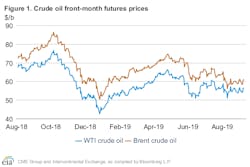EIA continues to lower oil price, demand growth forecasts
In its September Short-Term Energy Outlook, the US Energy Information Administration reduced its 2019 Brent crude oil price forecast to $63/bbl, which is $2/bbl lower than in its August STEO. The lower price forecast for this year largely reflects recent global crude oil price fluctuations and lower forecast global oil demand growth.
EIA has revised its expected global oil demand growth down to 900,000 b/d in 2019, about 100,000 b/d lower than the August forecast. Lower expected oil demand growth mainly reflects lower forecast gross domestic product growth and lower forecast demand from countries in the Organization for Economic Cooperation and Development.
“If realized, 2019 would be the first year when demand growth is less than 1 million b/d since 2011,” EIA said.
EIA expects that annual average Brent prices will slightly decrease in 2020 to $62/bbl, which is $3/bbl lower than EIA’s August STEO forecast.
Economic indicators
Global economic indicators continued to decline, contributing to oil price declines and volatility.
Manufacturing Purchasing Managers’ Indices (PMI) from several countries for August showed a contraction in manufacturing activity. PMI reports remained mixed for US, with the IHS Markit PMI still showing slight expansion, although at the lowest level since September 2009, while the Institute for Supply Management’s PMI showed contraction for the first time since 2016.
Reports on trade negotiations between the US and China also contributed to daily movements in global crude oil prices. On Aug. 23, West Texas Intermediate prices fell 2% when China announced a 5% tariff on its imports of US crude oil—the first time US crude oil was included in Chinese tariffs. However, Chinese imports of US crude oil have decreased in 2019 year-to-date compared with 2018, and China has imported more from other countries, including Saudi Arabia.
US crude oil production
EIA forecasts US crude oil production will average 12.2 million b/d in 2019, up by 1.2 million from the 2018 level. Forecast crude oil production then rises by 1 million b/d in 2020 to an annual average of 13.2 million b/d. The slowing rate of crude oil production growth reflects relatively flat crude oil price levels and slowing growth in well-level productivity.
Brent-WTI futures price spread
Notwithstanding the decline in overall price levels in August, several factors specific to the WTI market contributed to a narrowing of the Brent–WTI futures price spread since late July.
The Brent–WTI futures price spread settled at $4.79/bbl on Sept. 5, a decrease of $1.70/bbl since Aug. 1. On Aug. 19, the price spread decreased to $3.60/bbl, the narrowest spread since March 2018.
Crude oil prices in the Permian region increased during this period with the addition of two pipelines mid-month that reduced takeaway constraints to the Gulf Coast. The Cactus II crude oil pipeline added an estimated 670,000 b/d, and the EPIC Midstream natural gas liquids pipeline—repurposed to deliver crude oil—added about 400,000 b/d of capacity. The pipeline additions between the Permian and the US Gulf Coast reduced the need for crude oil to first transit through Cushing, lowering the cost of transportation to refineries and export terminals on the Gulf Coast.
Cushing crude oil stocks decreased by 10 million bbl from the third week in July through Aug. 23 likely as a result of less crude oil flowing to the storage hub from the Permian region. EIA expects the spread to widen slightly from the lows seen in mid-August, as regional markets rebalance and the spread settles closer to the new pipelines’ tariff from the Permian basin to the Gulf Coast.
US natural gas
The Henry Hub natural gas spot price averaged $2.22/MMbtu in August, down 15¢ from July. This summer, prices have declined amid rising gas production, despite high levels of both gas exports and consumption in the electricity generation sector.
Based on recent price movements and EIA’s assessment that gas production will be sufficient to meet expected demand and export levels at a lower price than previously forecasted, EIA lowered its Henry Hub spot price forecast for 2020 to an average of $2.55/MMbtu, 20¢ lower than the August forecast.
EIA forecasts that US dry gas production will average 91.4 bcfd in 2019, up 8 bcfd from 2018. EIA expects monthly average gas production to rise in late 2019 and then decline slightly during the first quarter of 2020 as the lagged effect of low prices in the second half of 2019 reduces natural gas-directed drilling. However, EIA forecasts that growth will resume in the second quarter of 2020, and gas production in 2020 will average 93.2 bcfd.
Gas storage injections have outpaced the 5-year (2014–18) average so far during the 2019 injection season as a result of rising production. At the beginning of April, the gas inventory injection season started with working inventories 28% lower than the 5-year average for the same period. By the week ended Aug. 30, working gas inventories were 82 bcf, or 3% lower than the 5-year average of 3,023 bcf. EIA forecasts that gas storage levels will be 3,769 bcf by the end of October, which is slightly higher than the 5-year average and 16% higher than October 2018 levels.
